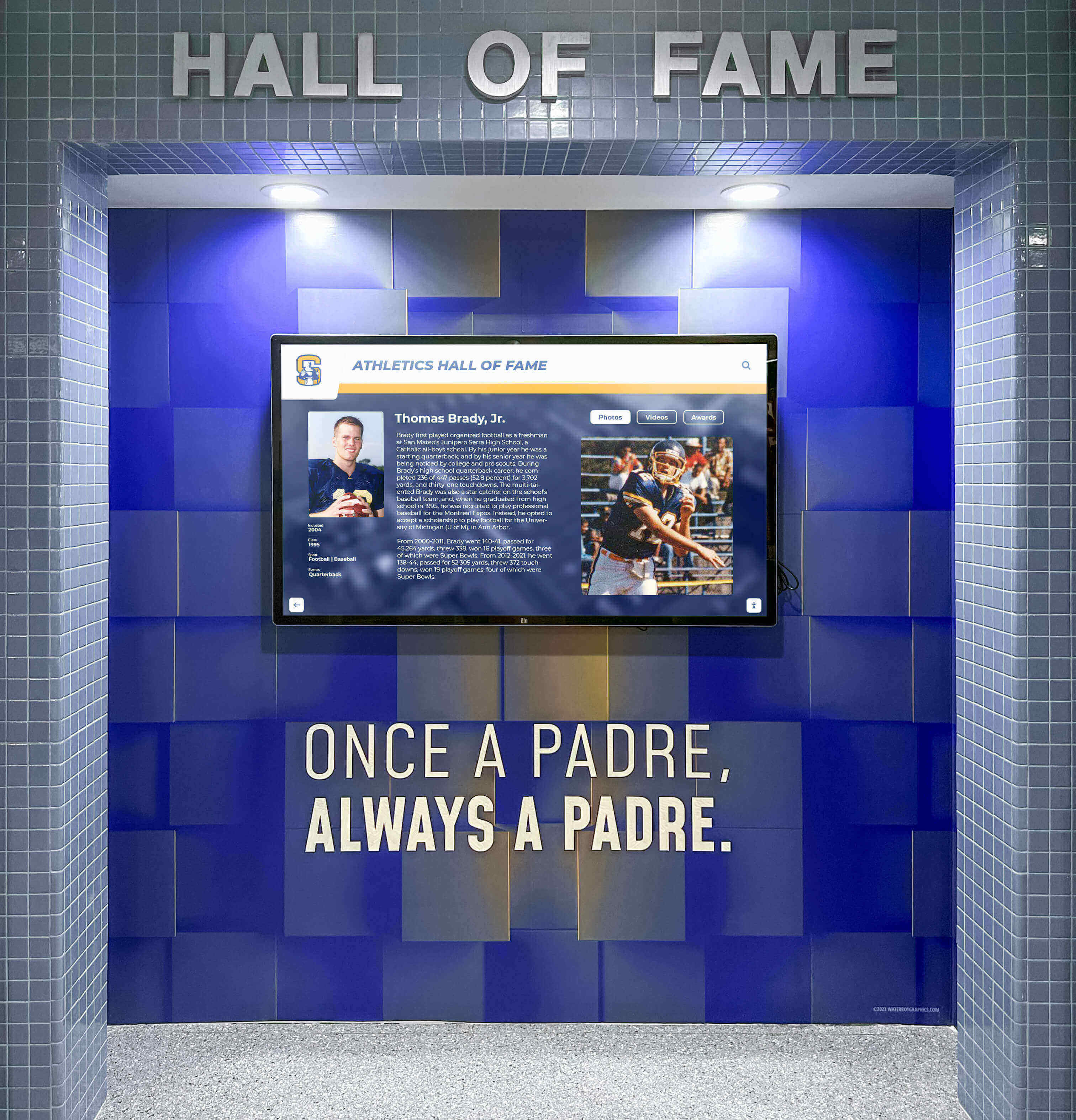Key Takeaways
Discover how all state plaque digital displays transform athletic recognition with unlimited capacity, instant updates, and engaging interactive experiences that inspire excellence.
Understanding All-State Athletic Recognition
All-state recognition represents the pinnacle of high school athletic achievement, acknowledging student-athletes who demonstrate exceptional skill, dedication, and competitive excellence. Unlike participation awards or team recognition, all-state selection identifies elite individual performers who rank among the best athletes across an entire state.
The Significance of All-State Achievement
Selection to all-state teams occurs through rigorous processes involving coaches’ votes, sports writers’ evaluations, and statistical performance analysis. Criteria vary by sport and state athletic association, but all systems aim to recognize the most outstanding performers in each sport annually.
For student-athletes, all-state recognition delivers multiple benefits including college recruiting visibility that attracts scholarship opportunities, validation of years of training and competition, permanent acknowledgment of elite performance, and inspiration for younger athletes to pursue similar excellence.
According to state athletic associations across the country, only approximately 2-5% of high school athletes in each sport achieve all-state recognition annually. This exclusivity makes proper celebration essential—these achievements represent extraordinary accomplishment deserving lasting commemoration.
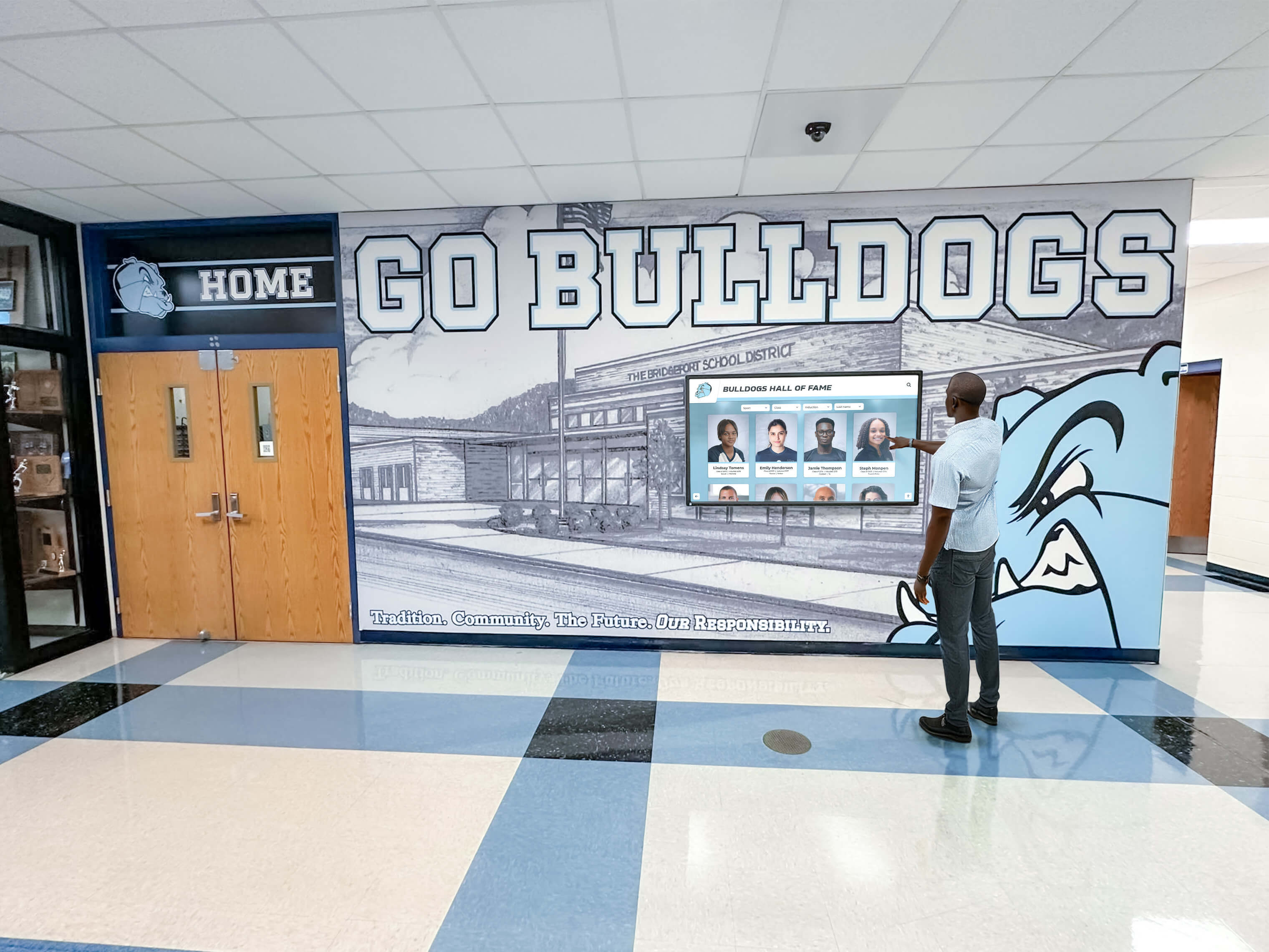
For schools, comprehensive all-state recognition creates visible evidence of athletic program quality, strengthens school pride and tradition, supports recruiting of future talented athletes, engages alumni through preserved recognition, and demonstrates institutional commitment to celebrating excellence.
Traditional All-State Plaque Recognition: Benefits and Limitations
For decades, schools have honored all-state athletes through engraved plaques mounted on walls in gymnasiums, athletic facilities, or main hallways. This traditional approach offers tangible permanence, familiar aesthetic that alumni appreciate, no technology requirements or dependencies, and relatively low ongoing costs after initial installation.
However, traditional plaque walls face inevitable limitations as programs mature and all-state athletes accumulate over decades of athletic excellence.
Space Constraints Force Difficult Decisions
Physical walls provide finite capacity. A standard plaque wall accommodating 100-200 names eventually reaches capacity, forcing schools to choose between stopping new recognition additions, removing older plaques to make space for recent athletes, expanding to additional walls with construction costs, or storing overflow plaques where they become invisible and effectively meaningless.
Programs with rich athletic traditions producing consistent all-state athletes particularly struggle with these space limitations. Schools commonly report having 15-25 years of plaques displayed while earlier decades of achievement sit forgotten in storage.
Physical Deterioration Diminishes Recognition Quality
Traditional plaques inevitably deteriorate over time through tarnishing and oxidation of metal plates, fading of engraving contrast, warping of backing materials in humid environments, mounting hardware failures causing plaques to fall, and accumulation of dust and dirt in high-traffic areas.
Maintenance requires regular cleaning, periodic refinishing, replacement of damaged components, and eventual complete replacement after 20-30 years. Many schools find that neglected plaque walls with deteriorating displays actually detract from rather than enhance athletic program image.
Limited Information Capacity
Space constraints on physical plaques restrict content to basic information—typically athlete name, sport, and year. This minimal approach fails to tell complete stories about achievements or provide context that makes recognition meaningful to audiences unfamiliar with the athletes being honored.
Details like specific positions, statistical accomplishments, team achievements during their careers, post-high school athletic paths, or memorable performances rarely appear on traditional plaques despite adding significant inspirational value.
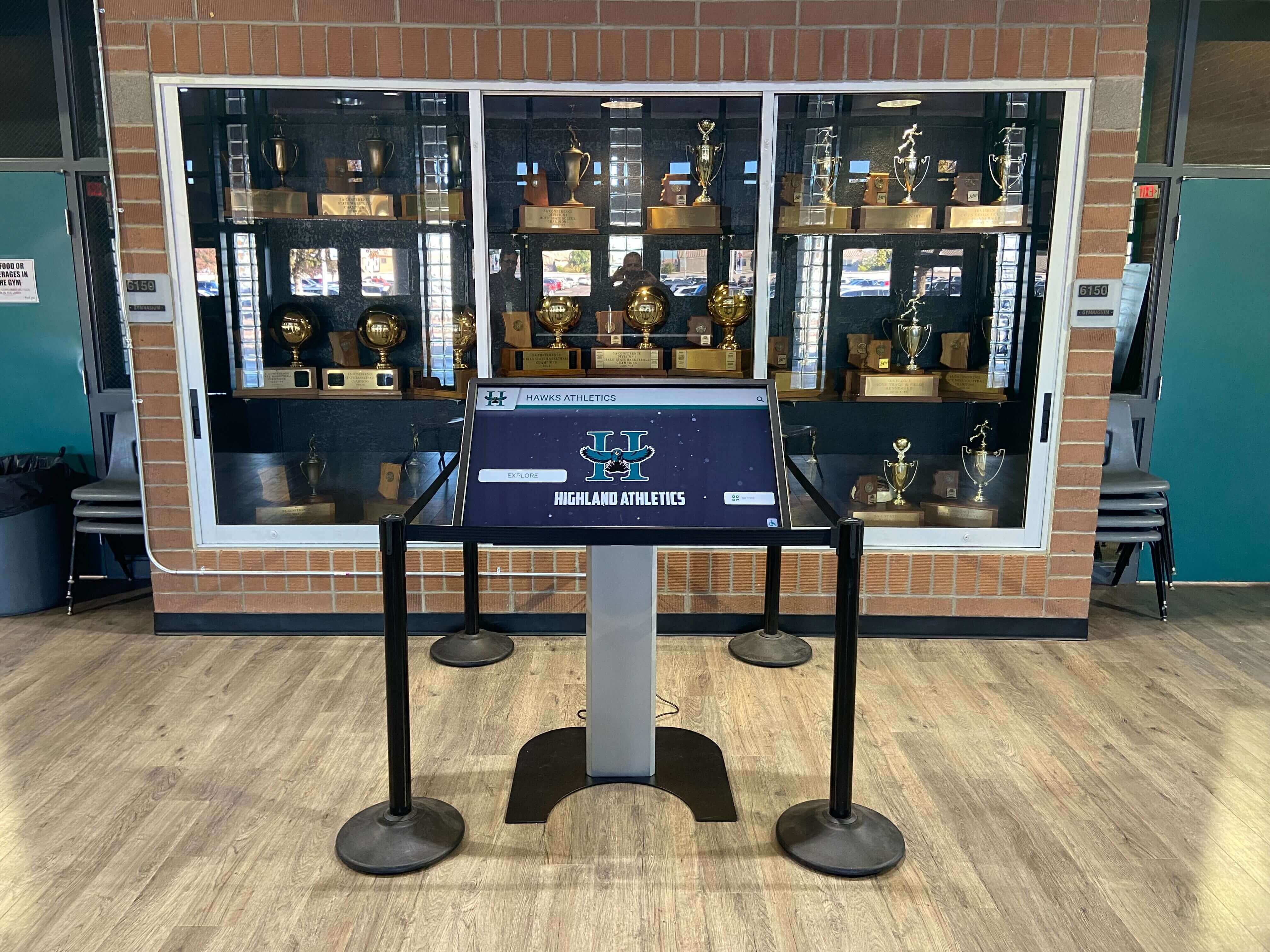
How Digital All-State Plaque Displays Transform Recognition
Digital recognition systems built on touchscreen technology and cloud-based content management overcome traditional limitations while amplifying recognition benefits in ways physical plaques cannot match.
Unlimited Recognition Capacity
Digital displays eliminate space constraints entirely. A single 55-inch touchscreen can showcase thousands of all-state athletes with comprehensive information for each—capacity that would require hundreds of square feet of traditional plaque wall space.
Schools implementing digital systems can recognize comprehensive athletic history from program inception forward, honor all-state athletes across all sports equally, include detailed profiles beyond just names and years, accommodate future achievements indefinitely without capacity concerns, and preserve archival information that would otherwise be lost.
Solutions like digital award displays provide purpose-built platforms specifically designed for athletic recognition rather than generic digital signage requiring extensive customization.
Instant Updates and Current Recognition
Traditional plaque updates require ordering custom engraving, scheduling installation appointments, waiting 2-4 weeks for production and mounting, and paying per-plaque costs of $75-$300 each. This timeline means athletes earning all-state recognition during fall sports often don’t see recognition appear until the following spring.
Digital systems enable immediate updates through cloud-based content management accessible from any internet-connected device. When an athlete earns all-state honors, recognition can appear within hours rather than months—celebrating achievement while excitement remains high rather than after the season becomes distant memory.
This immediacy transforms recognition from historical documentation into living celebration directly connected to current programs and athletes.
Rich Multimedia Storytelling
Traditional plaques convey minimal information constrained by physical engraving space. Digital recognition enables comprehensive storytelling through high-resolution action photographs, biographical information and background, complete statistics and career achievements, video highlights of memorable performances, post-high school athletic career updates, and context about significance and competitive level.
This multimedia depth transforms recognition from simple acknowledgment into compelling experiences that emotionally engage audiences and create lasting impressions. A digital profile can showcase a three-sport all-state athlete’s complete journey through high school athletics with photos, statistics, and narratives impossible to convey on a physical plaque.
Schools implementing comprehensive recognition for athletic achievements create unified pride while honoring diverse accomplishments across all sports and achievement levels.
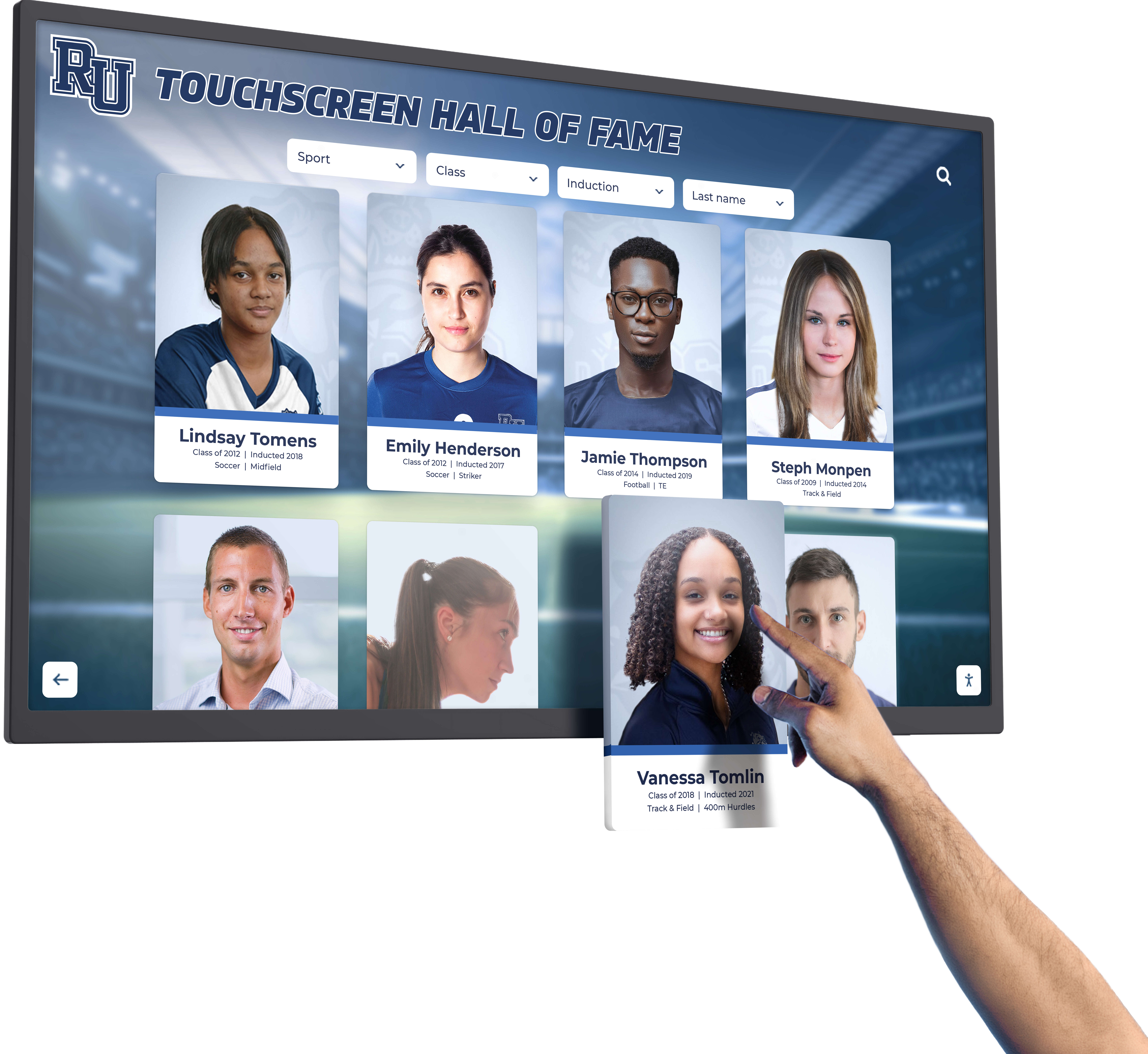
Interactive Exploration and Discovery
Static plaque walls force predetermined viewing sequences based on physical arrangement. Digital systems provide sophisticated exploration enabling athletes, families, and visitors to search by athlete name, graduation year, sport, or position, filter to specific sports or time periods, browse alphabetically or chronologically, view featured content highlighting notable achievements, explore related accomplishments and teammates, and compare statistics across different eras.
These capabilities ensure all achievements remain discoverable regardless of when they occurred, eliminating the “out of sight, out of mind” problem affecting older plaques relegated to less prominent positions on crowded walls.
Remote Accessibility and Extended Reach
Physical plaque walls reach only people who physically visit athletic facilities during hours when buildings are accessible. Digital recognition extends access globally through web-based viewing from any internet-connected device, mobile optimization for smartphone and tablet access, social media sharing extending visibility beyond campus, embedded integration in school websites, and alumni portals enabling remote exploration.
An all-state athlete who graduated in 1985 can now share their digital recognition with grandchildren living across the country. Current athletes can explore role models from previous decades. Prospective families researching athletic programs can view comprehensive recognition evidence demonstrating program excellence.
This extended accessibility transforms recognition from limited-audience displays into engagement platforms strengthening connections with distributed stakeholders.

Implementing Digital All-State Recognition Systems
Successfully transitioning from traditional plaques to digital recognition requires systematic planning addressing content, technology, and organizational considerations.
Content Development and Information Gathering
Comprehensive digital recognition begins with collecting information about all-state athletes across program history.
Historical Research Process
Many schools discover that complete records of historical all-state selections don’t exist in organized formats, requiring research through yearbook reviews documenting past athletes and statistics, newspaper archive searches capturing contemporary coverage, athletic department filing cabinets containing old records, coach and administrator interviews preserving institutional memory, state athletic association historical records, and alumni outreach requesting information and materials.
Create systematic inventory documenting athlete names and graduation years, sports and positions played, specific all-state honors and selection years, available photographs or memorabilia, team achievements during their careers, and post-high school athletic paths when known.
This research phase commonly takes 2-6 months for comprehensive programs depending on available resources and historical depth. Schools with strong archival practices complete research more quickly, while those with limited historical records may need extended timelines.
Content Standards and Consistency
Establish guidelines ensuring professional, consistent results across all athlete profiles including minimum required information for each athlete, optional enhanced content when available, photography standards and resolution requirements, naming conventions and formatting rules, and verification procedures ensuring accuracy.
Consistent standards ensure digital recognition maintains professional quality that appropriately honors elite athletic achievement while facilitating effective searching and filtering.
Platform Selection and Technical Requirements
Choose digital recognition platforms based on essential capabilities and organizational needs.
Critical Platform Features
Evaluate solutions based on intuitive content management requiring no technical expertise, appropriate categorization for sports-specific organization, photo and video integration supporting multimedia content, powerful search and filtering functionality, mobile-responsive web accessibility, appropriate security and access controls, reliable technical support and training resources, and analytics tracking engagement and usage patterns.
Platforms specifically designed for institutional recognition provide purpose-built features that general digital signage systems lack. Solutions like Rocket Alumni Solutions specialize in athletic and alumni recognition with interfaces optimized for school environments.
Hardware Considerations
Digital display hardware decisions impact visibility, engagement, and long-term satisfaction including display size appropriate for viewing distance and content volume (typically 55-75 inches for athletic facilities), commercial-grade touchscreens rated for high-traffic public use, installation options including wall mounting or freestanding kiosks, placement in high-visibility locations where athletes and visitors naturally congregate, and adequate power and network connectivity infrastructure.
Professional installation ensures proper mounting, clean aesthetics, and reliable operation. Many providers include installation services with platform subscriptions.
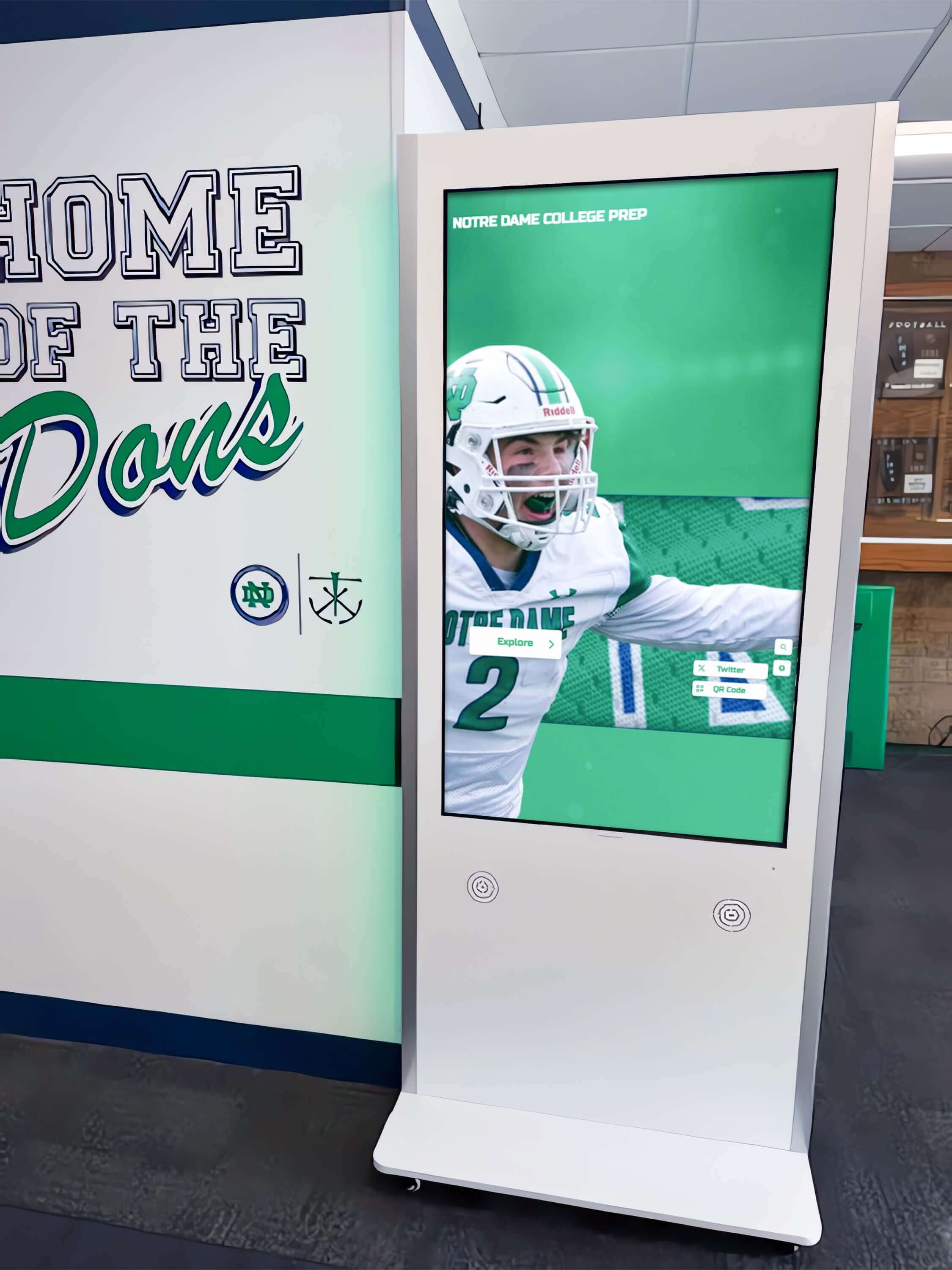
Budget Planning and Cost Analysis
Understanding comprehensive costs enables realistic planning and stakeholder buy-in for digital recognition investments.
Initial Implementation Investment
Typical startup costs include commercial touchscreen display with mounting hardware ($4,000-$8,000), content management platform setup and licensing ($2,000-$5,000), content development and historical digitization ($2,000-$6,000), professional installation and configuration ($1,000-$2,500), and staff training and change management ($500-$1,500). Total initial investment commonly ranges from $9,500-$23,000 for standard implementations.
Ongoing Operational Costs
Annual recurring expenses include software platform subscription and support ($1,200-$4,000), content updates and management (staff time), technical support and maintenance ($500-$1,500), and hardware warranty or replacement reserves ($300-$800). Total annual costs typically range from $2,000-$6,300.
Comparative Cost Analysis
Traditional plaque systems appear less expensive initially but accumulate substantial recurring costs including new plaques for each athlete ($75-$300 per athlete), mounting and installation labor ($50-$150 per plaque), space limitations eventually requiring expansion, periodic refinishing and maintenance, and replacement when deterioration becomes unacceptable.
For programs recognizing 15-25 new all-state athletes annually, digital systems typically achieve cost parity within 4-6 years while providing dramatically superior recognition capabilities throughout their 7-10 year operational lifespans.
Integration with Broader Recognition Programs
All-state recognition rarely exists in isolation. Most effective implementations connect to comprehensive athletic recognition including state championship teams and accomplishments, school records in various sports, significant milestone achievements like 1,000 career points, athletic hall of fame inductees, and coach recognition for program leadership.
Programs implementing comprehensive athletic walls of honor create unified recognition celebrating excellence across all dimensions rather than fragmenting recognition across disconnected displays.
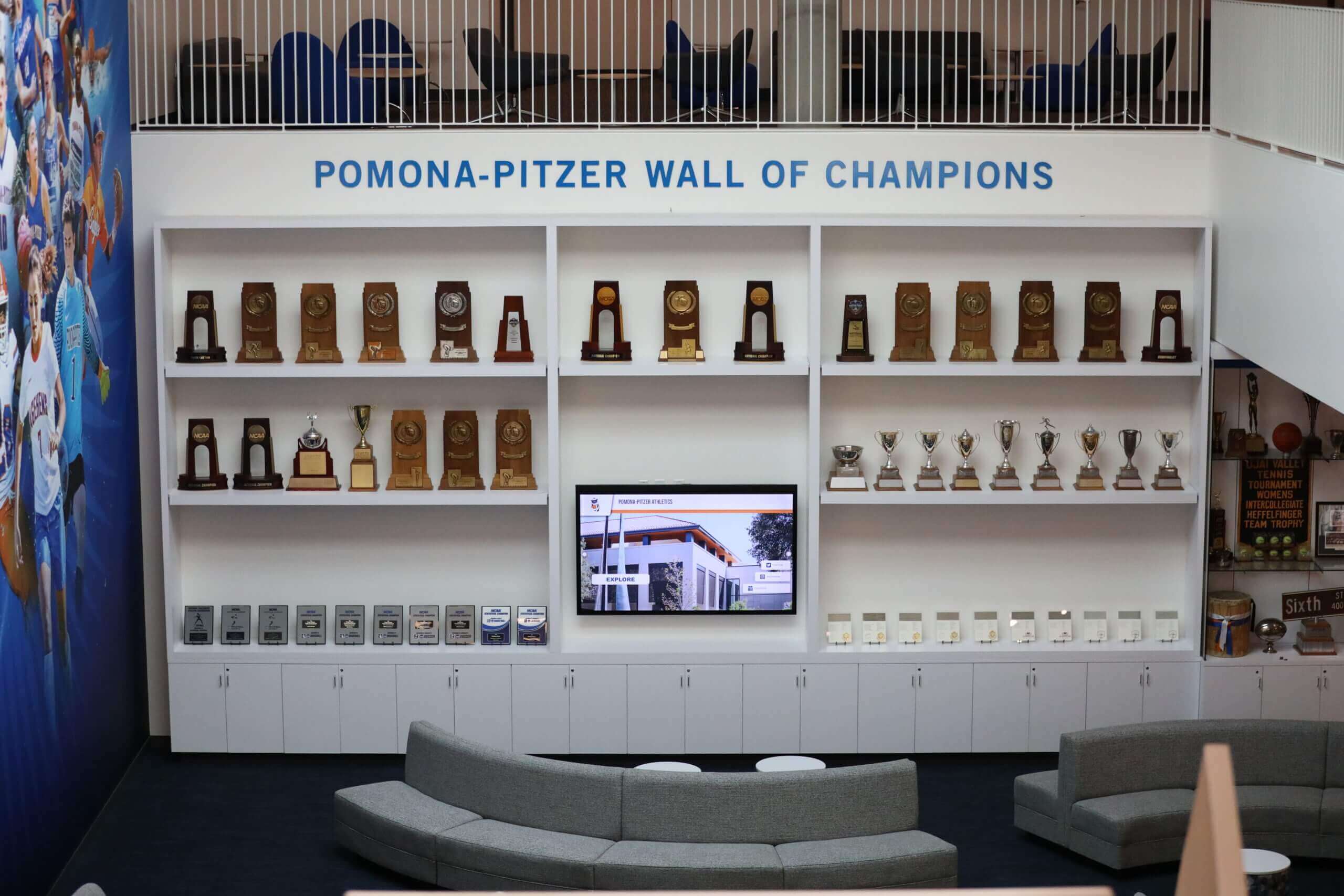
Best Practices for Maximizing Recognition Impact
Technology alone doesn’t guarantee successful recognition programs. Strategic implementation approaches amplify benefits and ensure long-term value.
Create Compelling Athlete Profiles
Transform basic name listings into meaningful recognition that celebrates complete achievements through detailed biographical information, comprehensive statistics and career highlights, high-quality action photography, position-specific context and achievements, team accomplishments during their careers, post-high school athletic paths, and brief narratives explaining what made them special.
Profiles averaging 150-300 words with 2-3 photos provide sufficient depth without overwhelming readers, while featured athletes can receive expanded coverage including video highlights and extended narratives.
Establish Systematic Update Processes
Sustainable recognition requires ongoing management ensuring displays remain current through designated staff responsible for content updates, coach/athletic director submission workflows for new athletes, approval procedures verifying accuracy before publishing, regular update schedules during recognition seasons, and enhancement cycles improving historical content as information emerges.
Organizations implementing structured maintenance approaches find that systematic processes make ongoing management efficient rather than overwhelming.
Promote Recognition Actively
Even exceptional displays require promotion to reach their potential impact through launch events creating awareness and excitement, social media campaigns showcasing featured athletes, integration with athletic events and ceremonies, alumni communications highlighting web accessibility, student orientation including display demonstrations, and media coverage generating broader visibility.
High-profile launches communicate that schools take recognition seriously while creating initial engagement momentum supporting sustained program success.
Measure Engagement and Demonstrate Value
Effective programs evaluate performance systematically through usage analytics including total interactions, popular content indicating athlete interest, search patterns revealing discovery behaviors, web portal visits from remote locations, and social sharing frequency extending reach.
Qualitative feedback from athlete satisfaction with recognition approach, family appreciation for comprehensive celebration, alumni engagement and connection, and prospective athlete impressions during recruitment validates quantitative metrics while informing ongoing improvements.
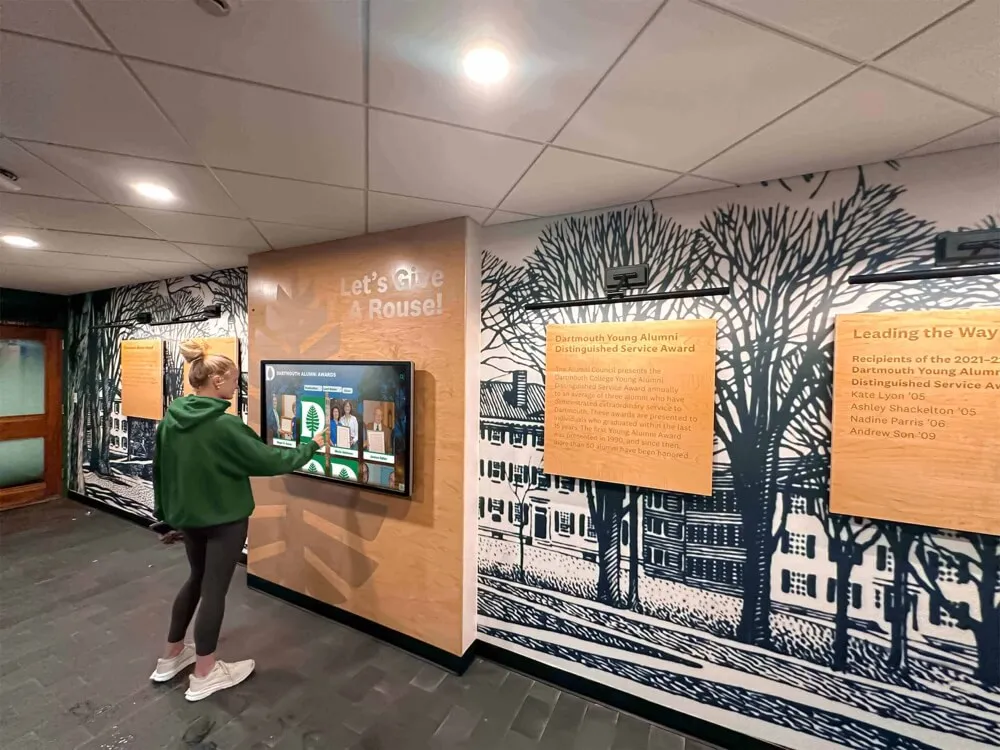
Common Questions About Digital All-State Recognition
Schools considering digital recognition commonly have legitimate questions about implementation and outcomes.
“How Do We Handle Existing Physical Plaques?”
Organizations transitioning to digital recognition must decide disposition of physical plaques already installed. Common approaches include selective retention of particularly significant plaques alongside digital systems, offering plaques to original athletes or their families, creating ceremonial documentation before transitioning to storage, or repurposing elements in artistic displays honoring overall athletic history.
No single correct approach exists—schools should choose strategies aligned with their values and community preferences. Many successful implementations maintain limited traditional displays for highest-profile recognition while digitizing comprehensive all-state records.
“Will Athletes and Families Prefer Physical Plaques?”
Some stakeholders initially question digital alternatives, particularly alumni who remember traditional displays fondly. However, experience shows that once communities explore digital recognition capabilities, initial skepticism typically transforms into enthusiasm as benefits become evident.
Emphasize that digitization enables honoring ALL athletes rather than only those fitting in limited space, multimedia content provides more meaningful recognition than objects behind glass, web accessibility benefits athletes and families through remote sharing, and enhanced storytelling creates lasting emotional connections.
“How Difficult Is Content Management?”
Modern digital recognition platforms are designed for non-technical users with cloud-based systems requiring no IT infrastructure, intuitive interfaces enabling updates in minutes, bulk import tools making additions efficient, mobile access allowing updates from any location, and provider support handling technical issues.
Schools consistently report that updating digital recognition requires less time than traditional plaque maintenance once systems are implemented and staff become familiar with management interfaces.
“What Happens to Recognition When Technology Changes?”
Valid concerns about long-term sustainability deserve consideration. Mitigation strategies include ensuring contracts establish content ownership with export capabilities, verifying standard formats (JPEG, CSV) rather than proprietary structures, periodically exporting complete backups for local storage, selecting established providers with demonstrated stability, and discussing transition procedures before implementation.
Reputable providers understand these concerns and structure services ensuring content protection and portability regardless of future technology evolution.
Sport-Specific Recognition Considerations
Different sports present unique recognition challenges requiring tailored approaches within comprehensive programs.
Team Sport All-State Recognition
Sports like football, basketball, soccer, volleyball, and baseball generate recognition through individual achievement within team contexts. Comprehensive recognition balances celebrating individual all-state performers while acknowledging team achievements creating environments where excellence flourishes.
Position-specific context matters—a defensive lineman’s impact differs from a quarterback’s statistics, yet both may represent elite achievement worthy of recognition. Digital systems accommodate position-appropriate narratives and statistics impossible to convey on simple plaques.
Individual Sport All-State Recognition
Track and field, cross country, swimming, wrestling, golf, and tennis feature individual competition requiring different recognition approaches than team sports. Event-specific context helps audiences understand achievement magnitude—state champion times, placements, and qualifying standards provide meaningful comparison across eras.
Digital platforms enable comprehensive event-by-event documentation with progression statistics showing how athletes improved over careers, comparative analysis against school records, and context about competition level and conditions.
Schools successfully implementing athletic record board displays demonstrate how digital recognition honors individual sport achievements appropriately while creating unified celebration across all athletic programs.
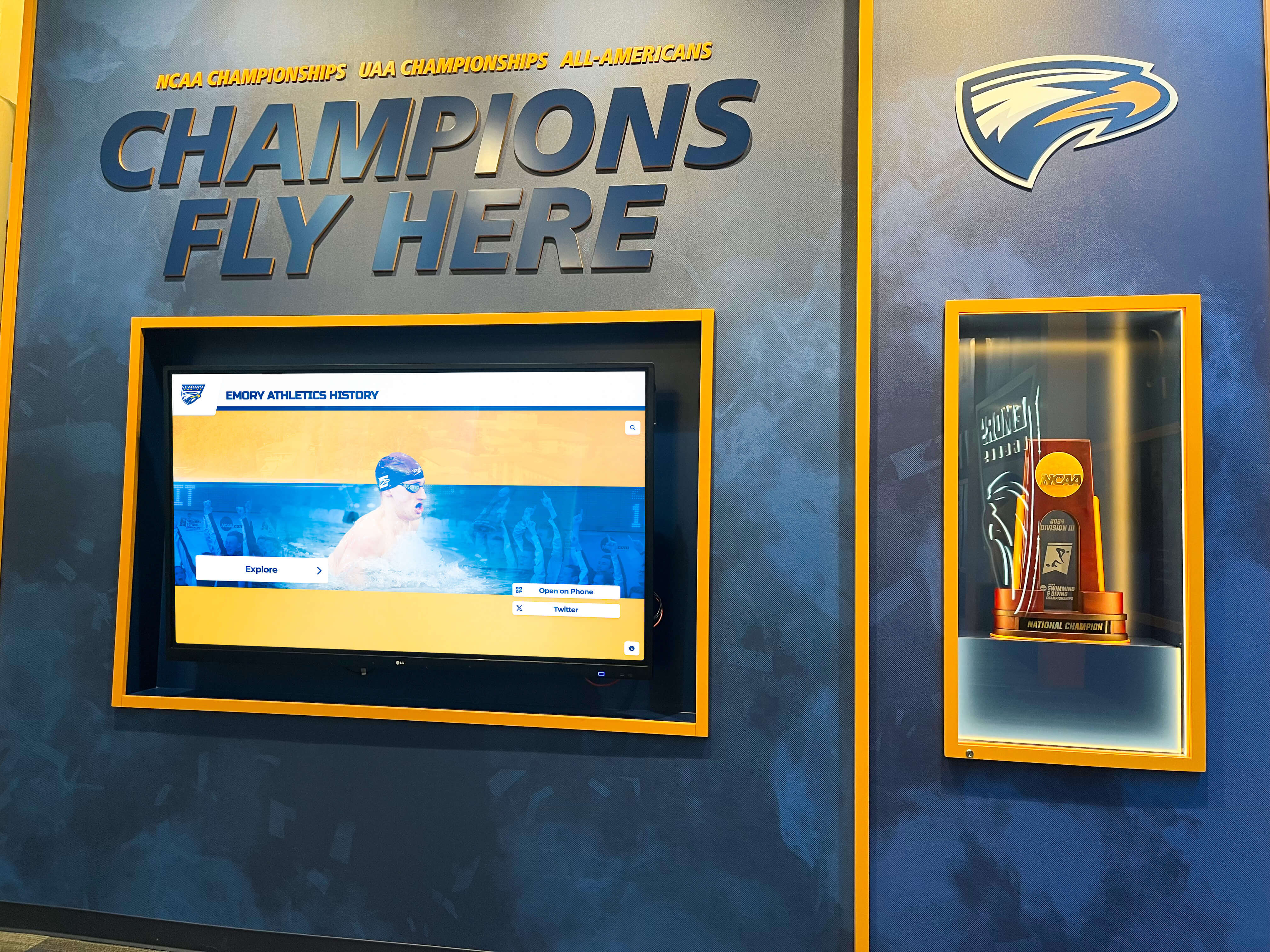
Conclusion: Honoring Excellence Through Modern Recognition
All-state athletic recognition celebrates extraordinary achievement deserving permanent, visible commemoration that inspires current athletes while preserving institutional legacy. Traditional engraved plaques served schools adequately for generations, but fundamental limitations—space constraints, limited information capacity, physical deterioration, and restricted accessibility—increasingly make them insufficient for comprehensive recognition needs.
Digital all-state plaque displays represent the next generation of athletic recognition, transforming celebration from space-constrained static listings into engaging interactive experiences that honor every elite athlete appropriately. Unlimited capacity ensures recognition for all deserving athletes rather than difficult choices about whom to acknowledge. Instant updates celebrate achievement while excitement remains high. Rich multimedia storytelling conveys complete athlete narratives beyond simple names and dates. Interactive exploration helps audiences discover achievements personally relevant to them. Remote accessibility extends recognition globally beyond campus visitors.
The most successful programs share common characteristics including comprehensive content celebrating complete athletic journeys, systematic processes ensuring sustainable management, active promotion creating awareness and engagement, strategic integration connecting all-state recognition to broader athletic celebration, and ongoing optimization based on usage data and stakeholder feedback.
Whether schools operate small single-sport programs or comprehensive athletic departments spanning dozens of teams, whether budgets allow immediate comprehensive implementation or require phased approaches, digital all-state recognition delivers measurable value through enhanced athlete motivation, preserved institutional history, strengthened program identity, improved recruiting, and deeper community connections.
Modern digital recognition solutions like those from Rocket Alumni Solutions enable schools to honor all-state excellence through intuitive platforms designed specifically for educational athletics. These systems combine unlimited recognition capacity with simple content management, creating professional displays that inspire current athletes while preserving program history for future generations.
Stop limiting recognition to what fits on finite wall space. Stop waiting weeks for manual updates to traditional plaques. Stop maintaining deteriorating physical displays requiring constant replacement. Modern digital all-state recognition provides comprehensive solutions honoring elite achievement while motivating current and future athletes through visible proof that excellence receives lasting acknowledgment.
Visit Rocket Alumni Solutions to explore how digital recognition transforms all-state athlete celebration from static displays into engaging experiences inspiring excellence across generations of student-athletes. Your program’s all-state athletes deserve recognition matching the significance of their achievements—permanent, professional, powerful, and accessible to everyone who values athletic excellence.
Contact us today to discuss implementing recognition solutions that honor your athletic tradition while building competitive culture where future all-state athletes flourish and legacy grows stronger with each season of championship-caliber performance.
